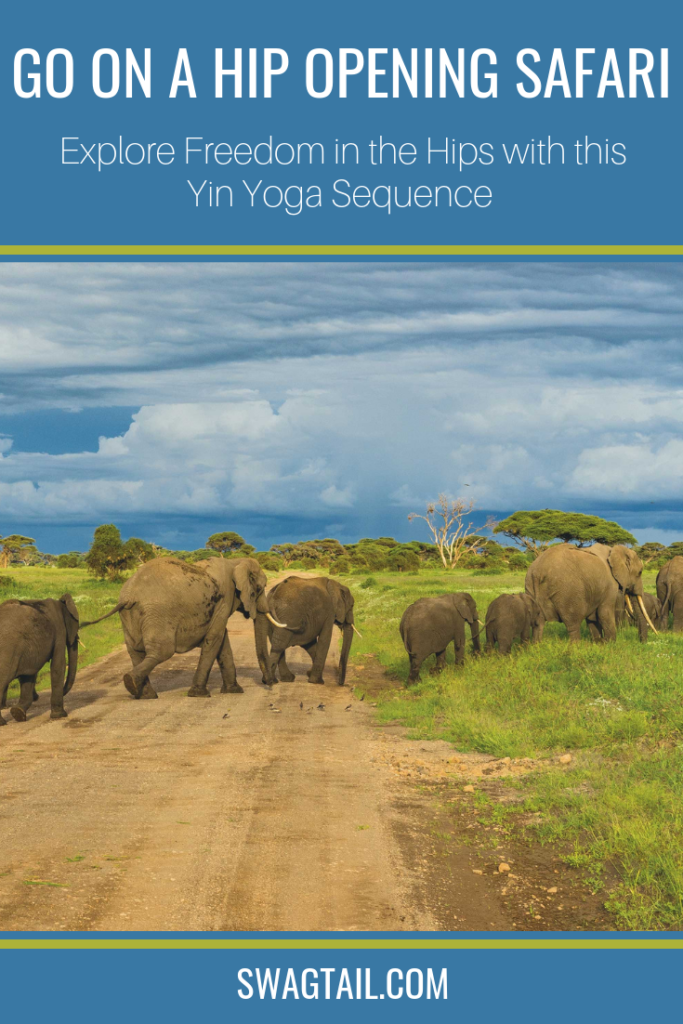 The terrain of the hips, much like the African plains, provide endless opportunities for exploration. The pelvic girdle consists of 3 pairs of bones, roughly 17 muscles, and connects the axial skeleton to the lower limbs. This structure determines how the spine rests and moves, and this hip opening yin yoga sequence is designed to create more freedom around the entire pelvic girdle. The end result? A happier, healthier spine!
The terrain of the hips, much like the African plains, provide endless opportunities for exploration. The pelvic girdle consists of 3 pairs of bones, roughly 17 muscles, and connects the axial skeleton to the lower limbs. This structure determines how the spine rests and moves, and this hip opening yin yoga sequence is designed to create more freedom around the entire pelvic girdle. The end result? A happier, healthier spine!
When I was training in South Africa, I had the pleasure of taking mini-safari. There were giraffes, lions, water buffalo, and rhinoceros that passed right beside our 4×4 vehicle. Being so close to these powerful and graceful animals was intoxicating! I felt reverence for their environment and great respect for their way of life.
The sense of adventure out in the open expanse is one you can bring every day to your yoga practice. Enjoy a sense of curiosity when you approach your hips. Respect the amount of work they do each day to allow you to walk, jump, and move in numerous ways. And, above all else, have fun in the process.
Photo Credit: Matthew Cramblett
THE HIPS
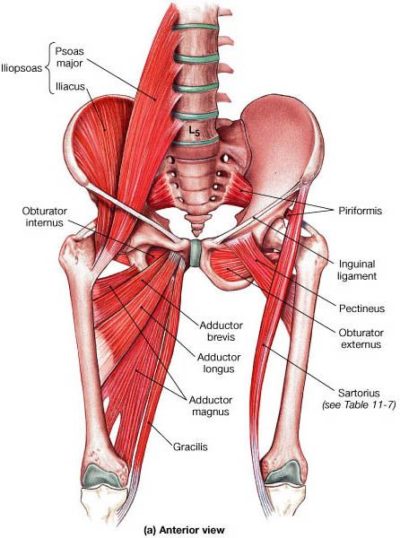 In order to understand the aim of this hip opening practice, let’s clarify what parts of the pelvic girdle we will be addressing. Here are some fun facts about the hips:
In order to understand the aim of this hip opening practice, let’s clarify what parts of the pelvic girdle we will be addressing. Here are some fun facts about the hips:
- In yoga, the “hips” are usually a quick way to reference the pelvic girdle.
- Your hip bones are made of paired bones, one on either side of your body–called the ilium, ischium, and pubis.
- The hip joint is where the head of the femur–or thigh bone–fits into the concave cavity in the hip socket is known as the acetabulum.
- There are 17 main muscles that allow the pelvis to move.
- The muscles around the hips are broken into four categories: adductors, glutes, external rotators, and flexors.
Essentially, the pelvis is a main point in the body that provides balance and support for the trunk. It’s also the place from which the trunk and legs find movement. Due to its complex nature, addressing this region often in a yoga practice is essential to physical balance.
OVERVIEW OF THE SEQUENCE
This sequence is designed to take 75-minutes. However, you can shorten or lengthen the time spent in each posture to satisfy the time frame in which you have to teach your class. This can be a fantastic practice for those individuals with tight muscles around the hips. It’s also a fantastic sequence to do during the first trimester of pregnancy, as it prepares the body for labor. As with most hip opening yoga practices, emotional tension stored in this region can also be eliminated.
Reminder: It’s best to hold the poses at about 50-60% of your maximum capacity when practicing yin yoga. We will offer modifications and support recommendations, should you want to make this more of a restorative-like practice as well. Make sure you also dress in a fashion where you will be warm the entire time. Since there is little movement in this practice, you want to maintain a comfortable body temperature throughout.
Props needed: Strap
Additional props (optional): blanket, bolster, blocks
(1) SAVASANA
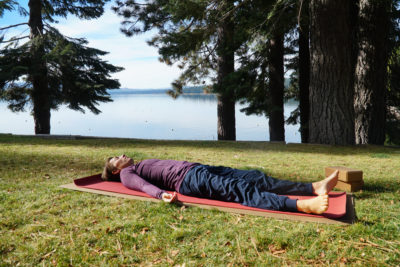 Purpose: The goal of starting on the back in a symmetrical, neutral position is to gauge the condition of the body in the present moment. Starting in stillness allows you to check in with physical sensations, mental fluctuations, and emotional patterns. It’s also a great place to set an intention for your time on the mat. Essentially, ask yourself, “how would I like to be different when I roll up my mat at the end of this class?”
Purpose: The goal of starting on the back in a symmetrical, neutral position is to gauge the condition of the body in the present moment. Starting in stillness allows you to check in with physical sensations, mental fluctuations, and emotional patterns. It’s also a great place to set an intention for your time on the mat. Essentially, ask yourself, “how would I like to be different when I roll up my mat at the end of this class?”
Length: 2-3 minutes
(2) SUPTA BADDHA KONASANA
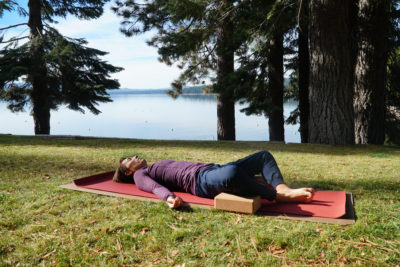 Purpose: We’ll start this sequence by opening up the adductor muscles. When these muscles are elongated, it makes poses such as warrior 2 and lotus more accessible. Flexibility in this region can lso make the birthing process much easier.
Purpose: We’ll start this sequence by opening up the adductor muscles. When these muscles are elongated, it makes poses such as warrior 2 and lotus more accessible. Flexibility in this region can lso make the birthing process much easier.
Length: 5 minutes
Additional Support:
- Move the feet away from the sitting bones to lessen the external rotation of the hips.
- Place blocks under the knees for support. This is especially important if you have a groin or knee injury.
Counterpose: Hug the knees into the chest and rock side to side.
(3) ANANDA BALASANA – HAPPY BABY
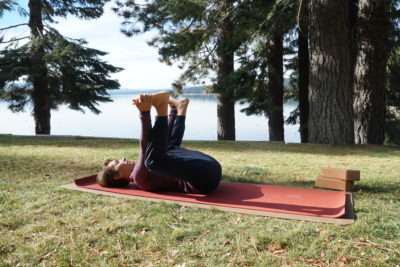 Purpose: Following reclined bound angle pose with happy baby continues to open the adductor muscles around the hip. It also lengthens the spine, opens the gluteul muscles of the hips, and further calms the brain.
Purpose: Following reclined bound angle pose with happy baby continues to open the adductor muscles around the hip. It also lengthens the spine, opens the gluteul muscles of the hips, and further calms the brain.
Length: hold for 1-2 minutes
Additional support:
- Use a strap to lasso your feet if they are far away
- Hug the knees toward the armpits, with the knees deeply bent, instead of reaching for the feet to make it easier.
Counterpose: Gently stretch one leg out at a time, and pause in Savasana for a minute.
(4) UPAVISTHA KONASANA
Purpose: Rock up to seated to yet another posture that lengthens the adductor muscle group. In addition to the inner hip opening, the hamstrings (which cross the hip joint) will lengthen as a result of having the legs extended. The muscles around the low back and spine will also get some attention.
Length: hold 3-5 minutes
Additional support:
- Place props under your sitting bones if you have a hard time sitting upright.
- Remain upright, instead of folding, if you notice your low back immediately starts to round
- Place blankets, blocks, or bolsters under the chest for additional support.
- Relax the neck and head as much as possible.
(5) PARIVRTTA JANU SIRSASANA – BOTH SIDES
Purpose: This is an incredible pose to open so much of the body. The extended leg stretches the hamstring. The bent knee continues to work the adductors. The sides of the body get longer, and the shoulders even get some love. It’s also a great pose to alleviate back pain and fatigue.
Length: hold 3 minutes each side
Additional support:
- Place block or blanket under bent knee if it does not reach the floor easily. You then have something to press against to help leverage the side body open.
- Take the arms out of the equation by placing your top arm behind your back, or bend the elbow and let forearm rest on top of the head
- Use a block next to your extended leg, or on top of it, to raise the floor up to you.
Counterpose: Find savasana in between sides.
(6) BADDHA KONASANA
Purpose: Baddha konasana, or bound angle pose, returns the body back to a symmetrical position. It’s also a great posture to improve circulation and continue to lengthen the adductors.
Length: hold 3 minutes.
Additional support:
- Place props under sitting bones.
- Use a bolster or blanket under the chest to offer more support. You can also use the seat of a chair to rest your head if the floor is very far away.
- Place blankets or blocks under the bent knees if they are far away from the floor.
Counterpose: Windshield wiper the knees. Or, stretch the legs out long and shake them out.
(7) FROG
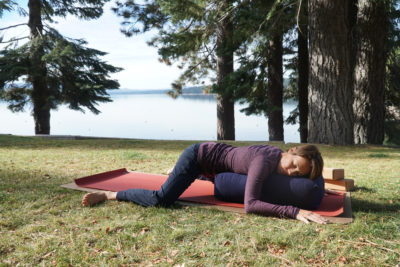 Purpose: Get even deeper into the adductors with this final inner thigh stretch–frog. While bhekasana can also refer to another posture that lengthens the front of the body, this yin pose is a great hip opening option to release stored tension in the tissues.
Purpose: Get even deeper into the adductors with this final inner thigh stretch–frog. While bhekasana can also refer to another posture that lengthens the front of the body, this yin pose is a great hip opening option to release stored tension in the tissues.
Length: Hold 3 minutes
Additional Support:
- Place bolster under chest for support.
- Set a blanket under the knees to give them extra cushioning
Counterpose: Come to all fours, or tabletop position. Press the floor away with the hands, and feel stability and length along the spine. Then, lift one knee at a time and make some hip circles. Repeat on the second side. For a more intense option before the next posture, make some hip circles from downward facing dog.
(8) DEER – BOTH SIDES
Purpose: Deer pose is a fantastic way to address mobility in the hips because one leg is internally rotated while the other is externally rotated. Thus, it’s a gateway in this sequence to move from inner thigh stretches to outer hip opening ones.
Length: 3-4 minutes each side
Additional Support:
- Support the front knee with a folded blanket
- Keep the front foot closer to the midline of the body if any strain felt on the knee joint.
- Place blocks under the bolster if the floor seems too far away
- Stay more upright, with hands on the floor, if the bolster seems too low.
Counterpose: Dandasana, or shake out the legs.
(9) RECLINED PIGEON
Purpose: This pose gets into the numerous external rotator muscles of the hip. Lying on the back once again also shifts the mind even more deeply into the relaxation mode. This is especially true since this will be the first of a series of poses on the back on the back also places you in the receptive mode.
Length: Hold 3-4 minutes
Additional support:
- Use a wall if you want additional support for the bottom leg.
- You can also place that bottom foot on a block.
Counterpose: Gently hug your knees into your chest and make circles with the knees. This motion is really initiated at the hip, so brings movement back after the longer holds in stillness.
(10) SUPTA PADANGUSTASANA
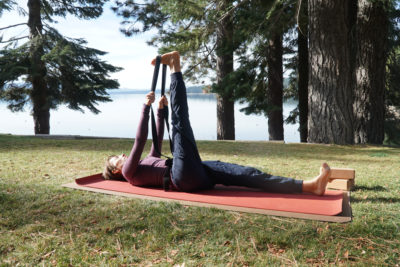 Purpose: In addition to lengthening the hamstring on the lifted leg, the hip flexor muslces get a stretch. This is also a preparatory pose for the revolved version coming up next.
Purpose: In addition to lengthening the hamstring on the lifted leg, the hip flexor muslces get a stretch. This is also a preparatory pose for the revolved version coming up next.
Length: Hold 3 minutes.
Additional Support:
- Use a strap if you cannot reach the foot with your hands
- Keep your lifted leg slightly bent to alleviate hamstring tension.
- Place a folded blanket behind your head if you have high blood pressure, or if you want to support your neck.
- Bend the knee of the leg closer to the group, even placing that entire foot on the ground. This will provide more space along the low back, and allow more attention to focus on the hamstrings.
Counterpose: If you want to rest in savasana for 30 seconds before moving on, do so. Otherwise, move right into pose 11.
(11) SUPTA PARIVRTTA PADANGUSTASANA
 Purpose: When you take the revolved hand to foot pose on your back, you once again including hip opening in the lateral rotators and gluteal groups.
Purpose: When you take the revolved hand to foot pose on your back, you once again including hip opening in the lateral rotators and gluteal groups.
Length: Hold 3 minutes
Additional Support:
- Place a block or bolster under the top (revolved) leg.
- Lower the top leg closer to the bottom one, lessening the angle between the two. This will make the stretch a bit easier.
Counterpose: Rest in savasana for 1-2 minutes before moving on to the second side.
(12) REPEAT 10 & 11 ON THE SECOND SIDE
(13) SAVASANA
 Purpose: This hip opening sequence comes full circle as students end in savasana like they began. The goal here is to be still and allow the changes made during your practice to settle into the body, mind, and spirit.
Purpose: This hip opening sequence comes full circle as students end in savasana like they began. The goal here is to be still and allow the changes made during your practice to settle into the body, mind, and spirit.
Length: 3-5 minutes
Additional Support: Use any props needed to get as comfortable as you can. Place a rolled towel behind your neck for support. Place a bolster under your knees to alleviate pulling on the low back, or even cover yourself with a blanket to feel additional warmth here.
PUTTING IT TOGETHER
The hips can hold a lot of stored energy around one-on-one relationships and our ability to feel connected to our personal power. When you take the time to relax and breathe into this area, you release any stuck energy (without need to go deeply into emotional issues that first caused the stress). Lengthening the adductors are also a great way to prepare for lotus, and each of the above poses are a fantastic way to prepare the body in the first trimester of pregnancy. Have fun exploring your body through this hip-opening sequence.


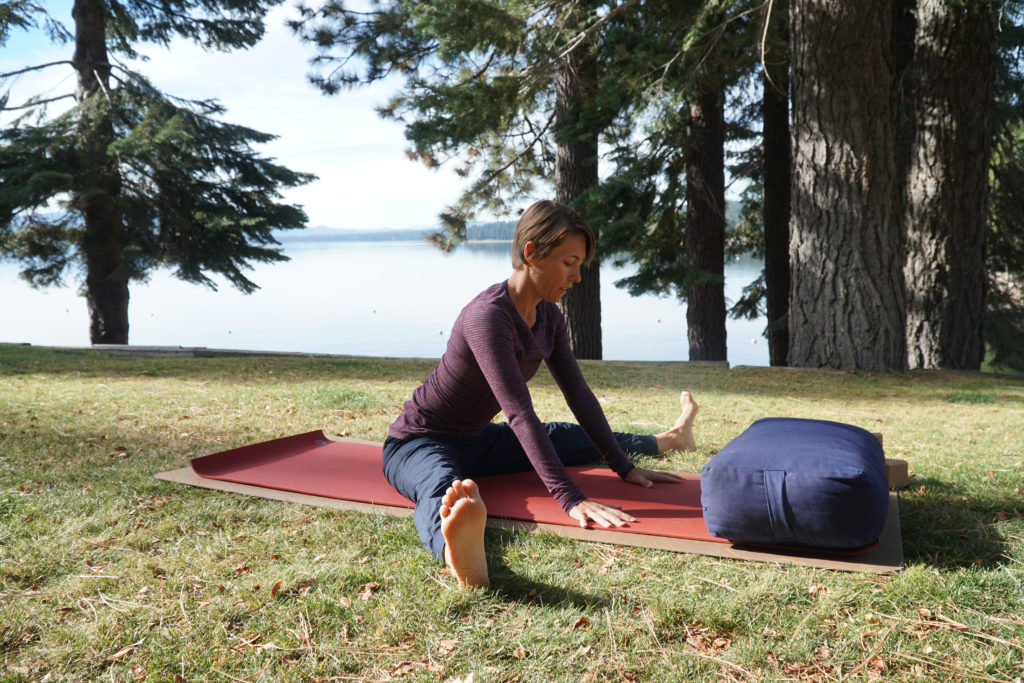
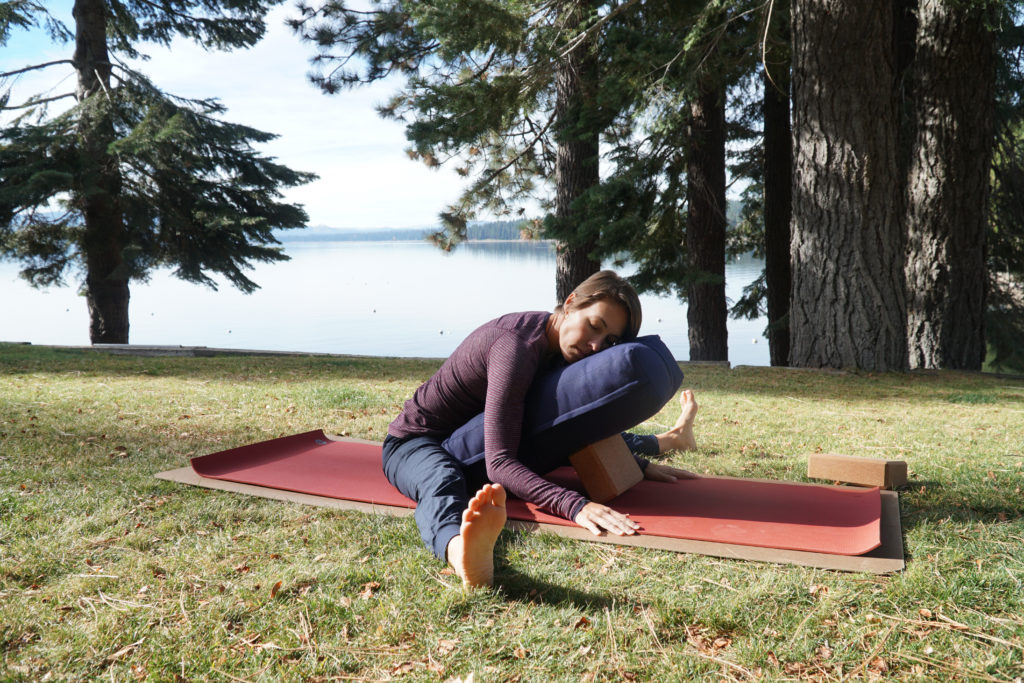
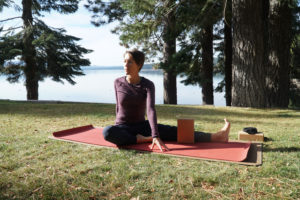
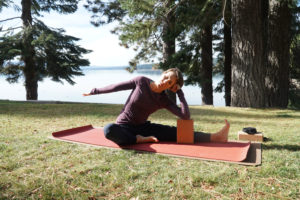
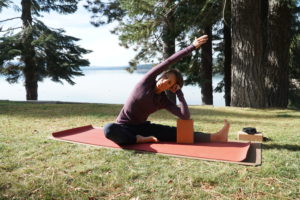
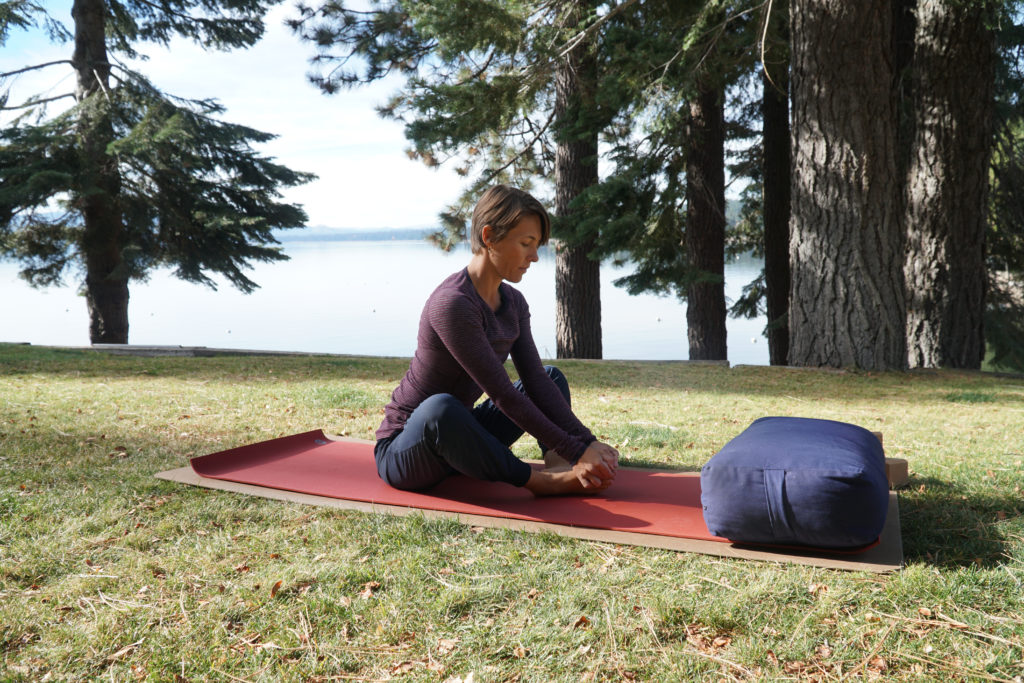
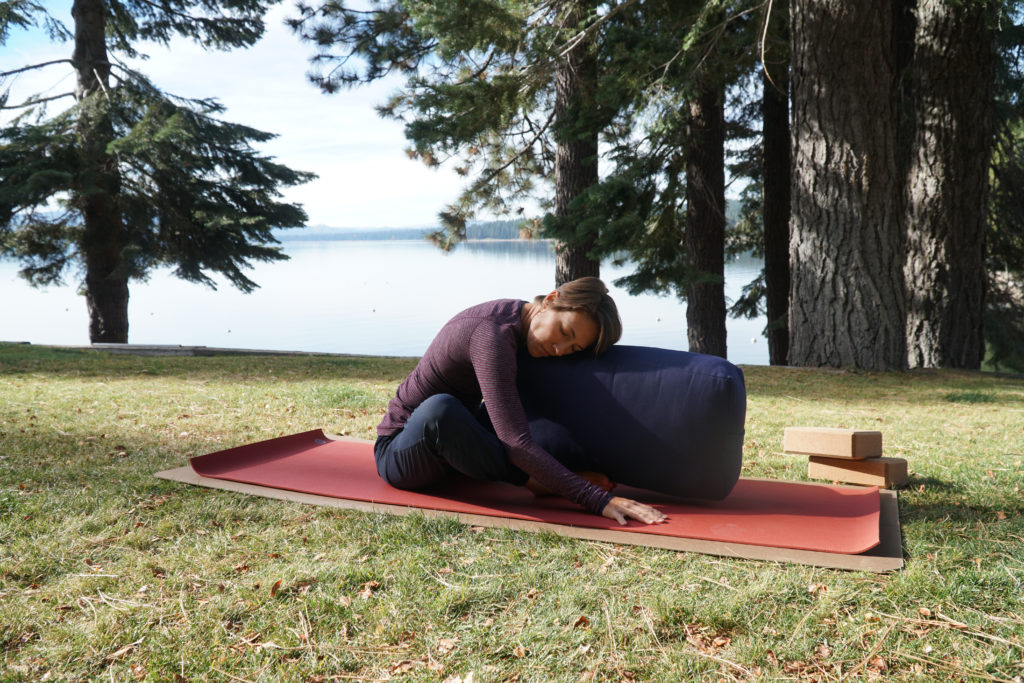
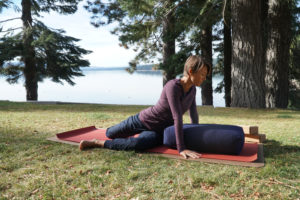
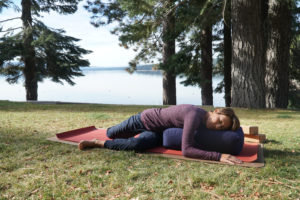
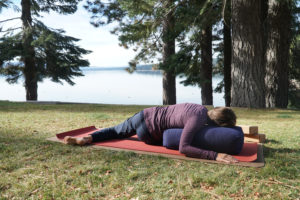
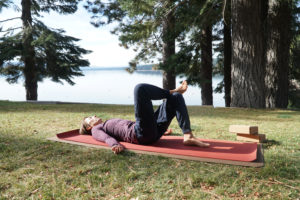
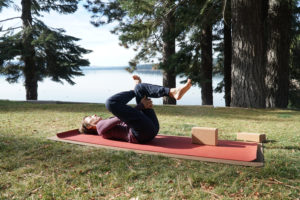
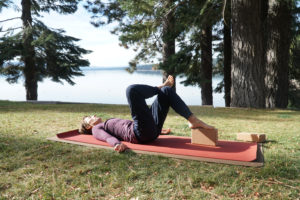
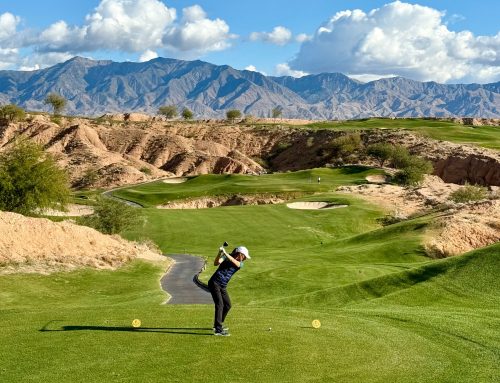
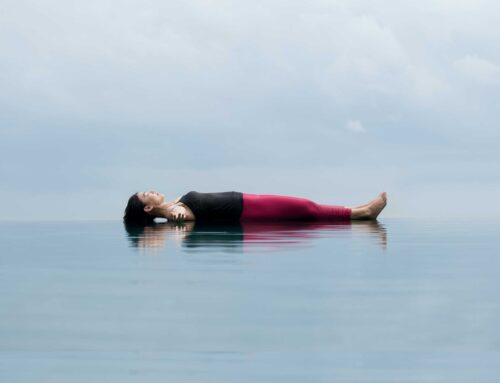

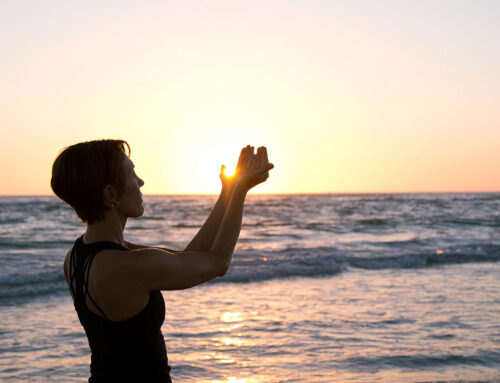
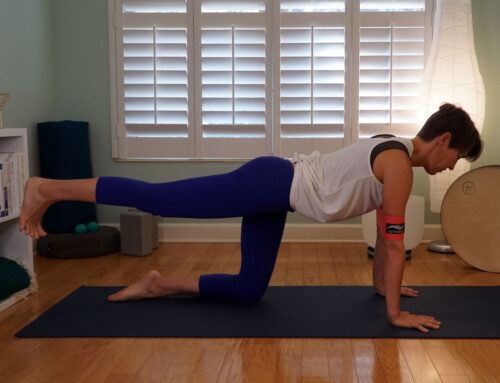
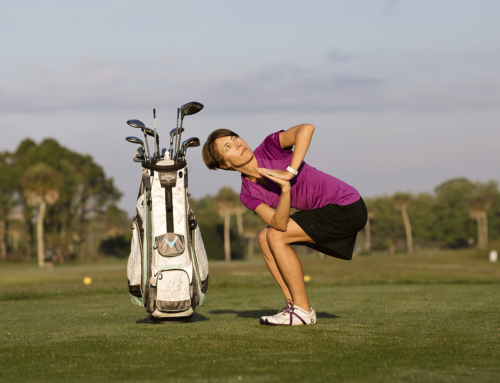
I like it very well and I’m going to try it thank you.